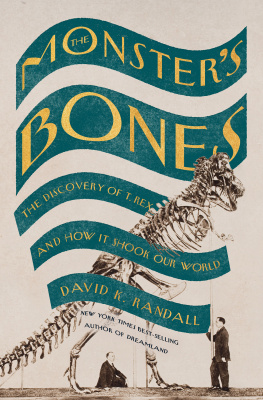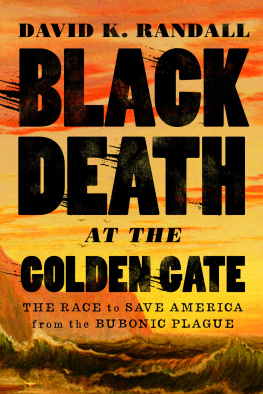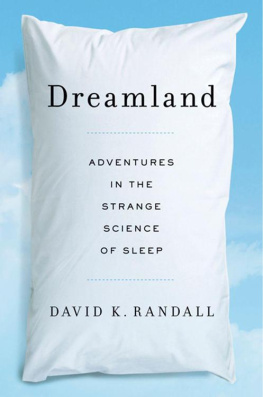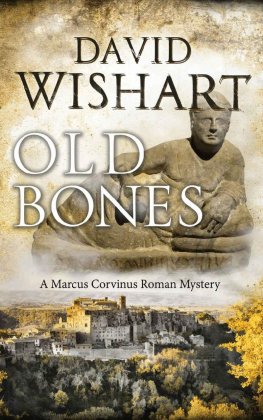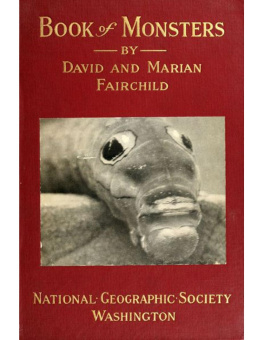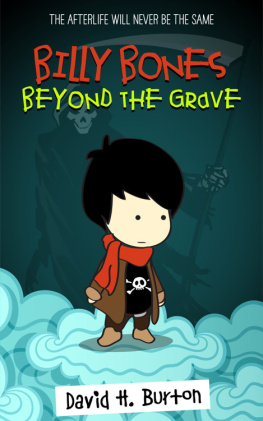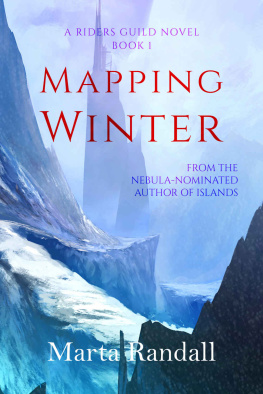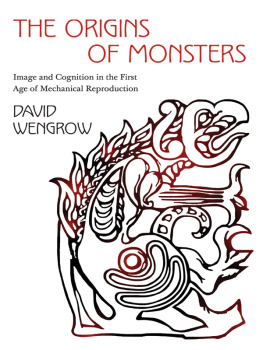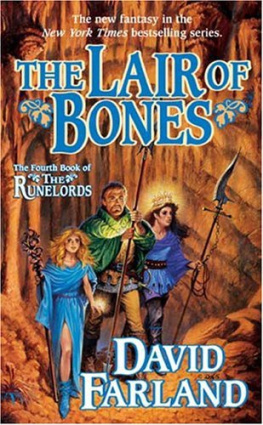David K. Randall - The Monsters Bones
Here you can read online David K. Randall - The Monsters Bones full text of the book (entire story) in english for free. Download pdf and epub, get meaning, cover and reviews about this ebook. year: 2022, publisher: Norton, genre: Detective and thriller. Description of the work, (preface) as well as reviews are available. Best literature library LitArk.com created for fans of good reading and offers a wide selection of genres:
Romance novel
Science fiction
Adventure
Detective
Science
History
Home and family
Prose
Art
Politics
Computer
Non-fiction
Religion
Business
Children
Humor
Choose a favorite category and find really read worthwhile books. Enjoy immersion in the world of imagination, feel the emotions of the characters or learn something new for yourself, make an fascinating discovery.
- Book:The Monsters Bones
- Author:
- Publisher:Norton
- Genre:
- Year:2022
- Rating:5 / 5
- Favourites:Add to favourites
- Your mark:
- 100
- 1
- 2
- 3
- 4
- 5
The Monsters Bones: summary, description and annotation
We offer to read an annotation, description, summary or preface (depends on what the author of the book "The Monsters Bones" wrote himself). If you haven't found the necessary information about the book — write in the comments, we will try to find it.
The Monsters Bones — read online for free the complete book (whole text) full work
Below is the text of the book, divided by pages. System saving the place of the last page read, allows you to conveniently read the book "The Monsters Bones" online for free, without having to search again every time where you left off. Put a bookmark, and you can go to the page where you finished reading at any time.
Font size:
Interval:
Bookmark:

The Discovery of T. Rex and How It Shook Our World
DAVID K. RANDALL


To Diane Randall,
who took me to every museum she could
Nature has a habit of placing some of her most attractive treasures in places where it is difficult to locate and obtain them.
CHARLES DOOLITTLE WALCOTT,
FOURTH SECRETARY OF
THE SMITHSONIAN INSTITUTION
DEPENDING ON WHICH ENTRANCE YOU CHOOSE, THE American Museum of Natural History looks like a castle the color of dried strawberries, a sun-bleached Roman temple or a spaceship ready to launch out of a glass box. The fact that its sides dont match is the first clue that, like the millions of once-living specimens that can be found within its maze of twenty-eight interconnected buildings in the middle of Manhattan, the museum grew organically, with something close to chance as a guide. Since its founding in 1869, the museum has gathered, categorized and displayed all that is amazing, strange and beautiful about the planet Earth and the universe in which it spins. To tour its collection is to viscerally experience the sum of human knowledge of the world surrounding us and our best guesses at how we fit into the picture.
The numbers alone are so large as to seem made up. Among the museums possessions are nearly seven million wasps, three million butterflies, one million birds and over two million fish, though they are no longer swimming. And thats just a modest survey of its extensive library of small animals. If the contents of the museum were taken across the street and laid out in Central Park like a gigantic yard sale, you could have your pick from the bones of 100 elephants, including the skeleton of Jumbo, once the most famous zoo animal in the world and the reason why the English language gained a new word for something particularly big; one thirty-four-ton meteorite called Ahnighito that is nearly as old as the Sun; more than 1,000 representations of the Buddha; 45 musical instruments from the Congo; the stump of a 1,400-year-old sequoia; 51 balls used in sports ranging from lacrosse to a game played by the Tupari people of South America, in which players could only touch the ball with their heads; the skeleton of a 3.1-million-year-old hominid woman that scientists named Lucy after a Beatles song that was playing on the radio; a set of dinosaur footprints that are at least 107 million years old; a 563-carat blue star sapphire known as the Star of India; a taxidermied Galapagos tortoise; a shirt woven by the Cheyenne decorated with locks of human hair; and a 4.5-ton block of azuritemalachite ore from Arizona that looks as if Jackson Pollock decided to paint a rock bright blue and green and which contains so much copper that it can vibrate and hum when the air becomes very humid, giving it the nickname the Singing Stone. Not to mention the dinosaur eggs, the worlds largest collection of spiders, the bones of the biggest hippo ever found, a 12-foot-long crab, a 55-pound slab of jade, a 63-foot-long canoe carved from the trunk of a single cedar tree and a life-size model of a blue whale hanging from the ceiling, which has its mouth closed because the chair of the Mammalogy Department wanted to prevent visitors from trying to throw things inside it.
How each wonder of the natural world came to sit in a museum in one of the most densely populated places on Earth is its own story. Yet even with an array of the splendid and surreal, it is no exaggeration to say that only a slice of the more than five million people who come to visit the collection of the American Museum each year would bother at all if it were not for one specimen: the Tyrannosaurus rex . It is the most iconic dinosaur in the world, the one creature for which seemingly everyone knows its full Latin name. Though the last of its kind died more than 66 million years ago, the massive jaws, tiny forearms and long teeth of a T. rex are as instantly recognizable as the Mona Lisa or the Eiffel Tower, its deadly beauty coming from a seamless pairing of form and purpose. It is not every day that one confronts a huge beast that, should it somehow become reanimated with muscle and memory, would clearly like nothing more than to crush your bones with its serrated teeth and eat you up in a gulp or two, like the monster from a childs nightmare made real.
For thirty years, the museum was the only place in the world where you could view a T. rex , and the specimen has called Manhattan home since before the construction of the Empire State Building. To a degree of no other object that can be found in a museum, the T. rex is quilted into modern culture, a fixture of everything from clothing to toy stores to blockbuster movies. Its familiarity makes it seem like it has always been with us. Yet there was a time not very long ago when everything about this prehistoric beast was entirely new, and the thud with which its discovery landed and shifted our understanding of ourselves and our planet reverberates still.
It seems odd to suggest that a species that last lived at least 60 million years before the appearance of the first species that could be called human ancestors somehow changed the course of modern life. The appeal of the T. rex , after all, rests in part on the fact that it is long dead, of no more mortal concern to us than a scary movie. It took a family trip to the American Museum one brisk fall morning for me to consider how a massive dinosaur once buried under layers of hard rock in Montana ended up in the middle of Manhattan. Growing up, I somehow dodged a dinosaur phase, never becoming the sort of person who could discuss with confidence why despite all appearances to the contrary the sail-backed prehistoric creature Dimetrodon was actually a distant relative of primitive mammals and not a dinosaur at all. With our kindergartener and preschooler in tow, my wife and I spent more than an hour walking through the dinosaur halls, though we somehow continued to loop back to the T. rex again and again. On the last lap, our son grew quiet, leaving us to exchange glances: perhaps the specimen, which had teeth nearly as long as his torso, was a little too frightening after all. Then he turned to us and asked, Who found these dinosaurs?
It was the first time I considered the human stories behind prehistoric bones. It soon became clear that in no small way the discovery and eventual display of the T. rex not only saved the American Museum from becoming an afterthought to the competing Museum of Modern Art on the other side of Central Park, but played a large part in bringing an appreciation and understanding of natural science into mainstream life. Dinosaur bones, of course, had long been a part of the natural landscape. But in the span of a generation, the work of a small group of men and women trying to find meaning in the remnants of a former world turned fossils from a biological curiosity into an attraction that brought millions into newly-opened museums to learn more about the mind-bogglingly long history of life on Earth. At a time when the notion of an unrecognizable Earth dominated by dinosaurs was a revolutionary idea, the T. rex resonated with the public like no other creature before it, the star whose name is listed at the top of the marquee.
This book tells the story of the discovery of one of the largest known predators in Earths history and the ways in which it continues to affect our lives. It is the tale of a spectacular competition among pioneering scientists, opportunistic cowboys and some of the wealthiest men the world has ever seen to find and display the largest dinosaurs on record, pushing our understanding of the planet and our place on it to new heights. The T. rex , the king of the prehistoric world, played an outsized role in the making of our modern one: robber barons saw in its carnivorous ferocity a justification of their own elevated powers; eugenicists found evidence of prehistoric domination which they used to support noxious theories of racial superiority; and ambitious dinosaur hunters discovered a path out of the narrow confines of their lives. Rather than a mirror into the past, the creature proved to reflect the concerns of the present.
Next pageFont size:
Interval:
Bookmark:
Similar books «The Monsters Bones»
Look at similar books to The Monsters Bones. We have selected literature similar in name and meaning in the hope of providing readers with more options to find new, interesting, not yet read works.
Discussion, reviews of the book The Monsters Bones and just readers' own opinions. Leave your comments, write what you think about the work, its meaning or the main characters. Specify what exactly you liked and what you didn't like, and why you think so.

